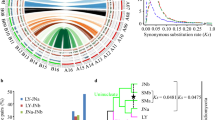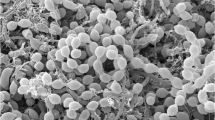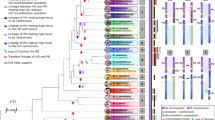Summary
The random migration of meiotic products to give binucleate spores in secondarily homothallic basidiomycetes gives frequencies of nuclear association which have not previously been recognised.
For a single segregating factor in two-spored species, the probability of a basidiospore receiving unlike nuclei is twice that of it receiving like nuclei. Consequently random spore progenies can be expected to yield genotypic ratios of 1:4:1 with the heteroallelic class predominating. If eight nuclei are present in the basidia of four-spored species then random migration would favour unlike over like pairing in the proportion 4:3; this would give a genotypic ratio of 3:8:3. Extrapolations are made for two and n factors, and the expected phenotypic ratios for mating-type factors, auxotrophic markers and sporophore characters are derived. Second division segregation and chromosome mapping are also considered.
Random nuclear migration in secondarily homothallic basidiomycetes favours heteroallelism and provides a simple explanation for the regularly observed preponderance of isolates heteroallelic for mating-type.
Similar content being viewed by others
Article PDF
References
Burnett, J H. 1956. The mating systems of fungi I. New Phytol, 55, 50–90.
Burnett, J H. 1975. Mycogenetics. Wiley, London.
Burnett, J H, and Boulter, M E. 1963. The mating systems of fungi II. Mating systems of the gasteromycetes, Mycocalia denudata and M. duriaeana. New Phytol, 62, 217–236.
Elliott, T J. 1972. Sex and the single spore. Mushroom Sci, 8, 11–18.
Elliott, T J. 1979. A gene affecting gill structure in Agaricus bisporus, the cultivated mushroom. Trans Br mycol Soc, 73, 347–348.
Evans, H J. 1959. Nuclear behaviour in the cultivated mushroom. Chromosoma, 10, 115–135.
Fincham, J R S, Day, P R, and Radford, A. 1979. Fungal Genetics, 4th Ed. Blackwell Scientific Publications, Oxford.
Kemp, R F O. 1974. Bifactorial incompatibility in the two-spored basidiomycetes Coprinus sassii and C. bilanatus. Trans Br mycol Soc, 62, 547–555.
Kligman, A M. 1943. Some cultural and genetic problems in the cultivation of the mushroom Agaricus campestris Fr. Am J Bot, 30, 745–763.
Kuhner, R. 1954. L'amphithallie et ses causes dans la forme bisporique tétrapolaire de Clitocybe lituus Fr. Bull Soc mycol Fr, 69, 307–325.
Kuhner, R, Lamoure, D, and Fichet, M L. 1962. Geopetalum (Pleurotus) longipes (Boudier), morphologie—caryologie—sexualité. Bull Soc mycol Fr, 78, 135–154.
Lange, M. 1952. Species concept in the genus Coprinus, a study on the significance of intersterility. Dansk bot Ark, 14, 1–164.
Miller, R E, and Kananen, D L. 1972. Bipolar sexuality in the mushroom. Mushroom Sci, 8, 713–718.
Miller, R E, Robbins, W A, and Kananen, D L. 1976. Inheritance of sporophore colour and “wild” morphology in Agaricus bisporus. Mushroom Sci, 9, 39–45.
Raper, C A, Raper, J R, and Miller, R E. 1972. Genetic analysis of the life-cycle of Agaricus bisporus. Mycologia, 64, 1088–1117.
Rizet, G, and Engelman, C. 1949. Contribution a l'etude genetique d'un ascomycete tetraspore Podospora anserina. Rev Cytol Biol Veg, 11, 201–304.
Sansome, E R. 1946. Maintenance of heterozygosity in a homothallic species of the Neurospora tetrasperma type. Nature, Land, 157, 484–485.
Sass, J E. 1929. The cytological basis for homothallism and heterothallism in the Agaricaceae. Am J Bot, 16, 663–701.
Sequiera, L. 1954. Nuclear phenomena in the basidia and basidiospores of Omphalia flavida. Mycologia, 46, 470–483.
Sinden, J W. 1937. Details of some experiments with different types of compost. BullPenn agric Exp Stn, 352, 38.
Skolko, A J. 1944. A cultural and cytological investigation of a two-spored basidiomycete, Aleurodiscus canadensis n.sp., Can J Res, Section C, 22, 251–271.
Whitehouse, H L K. 1957. Mapping chromosome centromeres from tetratype frequencies. J Genet, 55, 348–360.
Author information
Authors and Affiliations
Rights and permissions
About this article
Cite this article
Langton, F., Elliott, T. Genetics of secondarily homothallic basidiomycetes. Heredity 45, 99–106 (1980). https://doi.org/10.1038/hdy.1980.53
Received:
Issue date:
DOI: https://doi.org/10.1038/hdy.1980.53
This article is cited by
-
Spore behaviors reveal a category of mating-competent infertile heterokaryons in the offspring of the medicinal fungus Agaricus subrufescens
Applied Microbiology and Biotechnology (2016)
-
Segregation of genetic markers in the two-spored secondarily homothallic basidiomycete Coprinus bilanatus
Theoretical and Applied Genetics (1989)
-
Gene segregation in the two-spored basidiomycete Coprinus bilanatus
Heredity (1985)
-
Breeding systems and heterozygosity in populations of tetrad forming fungi
Heredity (1984)
-
Strain improvement in the cultivated mushroom Agaricus bisporus
Euphytica (1981)



